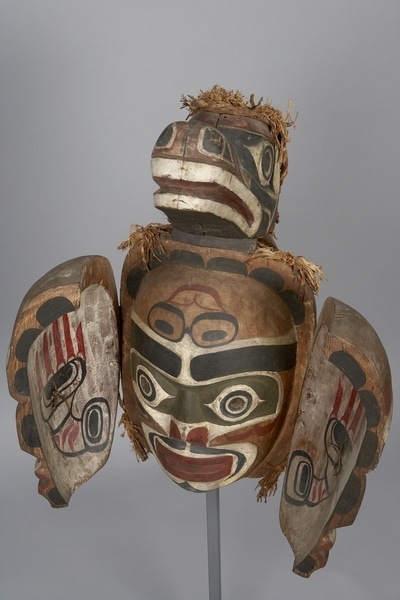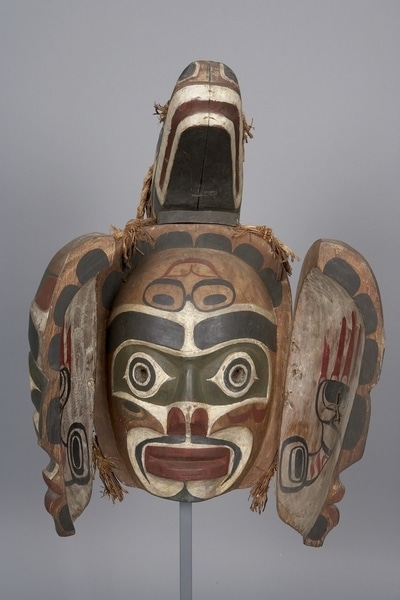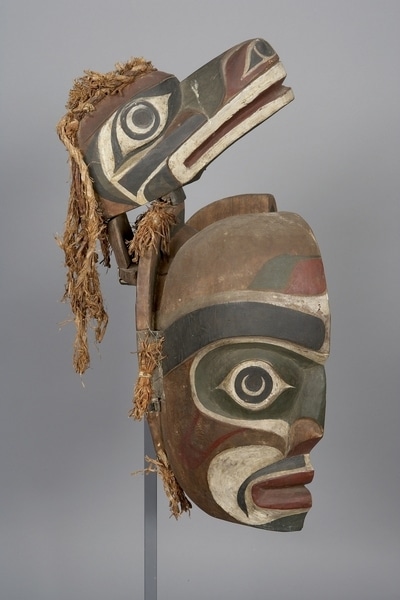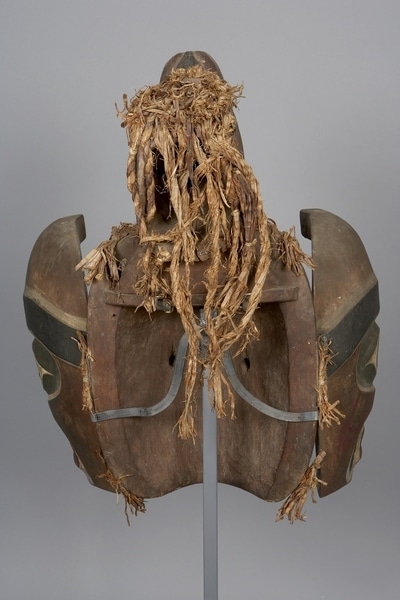Transformation Mask Item Number: A17140 from the MOA: University of British Columbia




Description
Wooden, carved, oval shaped, human transformation mask with a small bear mounted on the head like a headdress. The front of the mask is a large human face with red mouth and nose, black moustache and black outlined eyes on a white circular background surrounded by a green ovoid. The face is outlined in white. The bear has a long snout painted black with white edging. The nose and mouth are red. The mask splits down the centre and opens to expose another human/whale face. The inner face is detailed exactly like the outer face with the exception of killer whale motifs painted on the cheeks and forehead. The eyes have drilled holes. The opened boards are hinged with leather and nails; they are painted white with human hands and arms. The back of the bear has many twisted cedar strips that hang. The outer face is lined with small bundles of cedar. The mask is painted dark green, black, white and red with Northwest Coast stylized designs.
History Of Use
Early 20th century Imas (ancestor) transformation dance mask. Outer face opened by means of strings inside at the appropriate moment to reveal the inner character. Complex or transformation masks were one of the most dramatic and colourful aspects of Kwakwaka'wakw ceremonial life, where they reached their highest development. These masks were worn to the accompaniment of songs and drumming. At the appropriate moment the strings inside the mask were pulled and the outer mask flew open, disclosing the second mask within, typically a different character. At the beginning of the Tseka (winter ceremonial, or red cedar bark ceremony), during which the deceased carrier of the ancestral name it represents, a high-ranking chief, comes back one last time to pass on his rights and privileges. This particular Imas mask depicts the ancestor Nulis, who came down in the guise of a grizzly bear at Wakanukw, located on Tribune Channel in Knight Inlet. The mask's dance re-enacts the historic event where the holder of the Nulis name, with the help of his crest figure, the supernatural bear, vanquished a sisiyutl (double-headed sea-serpent) who was damming the river, blocking access to the salmon and other resources.
Iconographic Meaning
In both their conception and construction these masks expressed the dual nature of the mythological and supernatural beings they represent. Fraser suggests such a mask as this may have been used to portray a mythological hero in different states of mind or as he emerged in new form during the course of a myth.
Narrative
This mask is one in a series produced for the carrier of the Nulis name.
Item History
- Made in British Columbia, Canada between 1900 and 1920
- Owned by Walter C. Koerner before January 1973
- Received from Walter C. Koerner (Donor) during January 1973
What
- Name
- Transformation Mask
- Identification Number
- A17140
- Type of Item
- mask
- Material
- cedar bark, wood, leather skin, paint and metal
- Manufacturing Technique
- carved and painted
- Overall
- height 61.6 cm, width 28.2 cm, depth 32.2 cm
Who
- Culture
- Kwakwaka'wakw
- Previous Owner
- Walter C. Koerner
- Received from
- Walter C. Koerner (Donor)
Where
- Holding Institution
- MOA: University of British Columbia
- Made in
- British Columbia, Canada
When
- Creation Date
- between 1900 and 1920
- Ownership Date
- before January 1973
- Acquisition Date
- during January 1973
Other
- Condition
- fair
- Current Location
- Case 27
- Accession Number
- 0233/0006